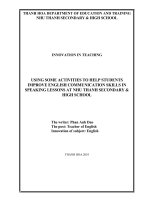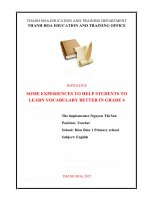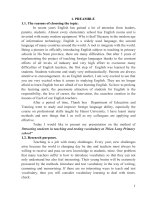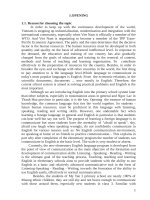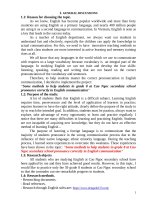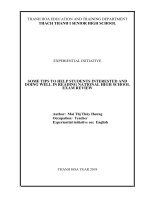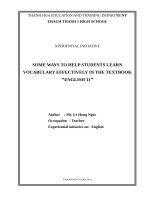Some tips to help students remember english vocabulary in elementary school
Bạn đang xem bản rút gọn của tài liệu. Xem và tải ngay bản đầy đủ của tài liệu tại đây (440.36 KB, 21 trang )
1. BACKGROUND
1.1. The reason for choosing topics
In order to catch up with the trend of global integration, Vietnam's education sector is
increasingly integrated with the world. Understanding the importance of modern education is
the training of people who can keep up with the trend of global integration. Foreign
languages in general, English in particular is a powerful tool for the integration process.
Many foreign companies have invested in Vietnam, the number of foreigners to travel, work
in our country more and more. In addition, the number of Vietnamese students studying
abroad has also increased significantly, and according to a recent statistic it has been stated
that Vietnamese students are no less important than students from other countries. Get
knowledge, scientific research, the order of study. However, the majority of Vietnamese
students face many difficulties in studying and living abroad because foreign language,
especially English, is very limited. But how to prepare good knowledge of foreign
languages, perhaps most students have to prepare English since elementary school.
The improvement of teaching methods in a positive way, promoting creative initiative and
self-learning capacity of students is the basic solution to improve education. Therefore, the
Ministry of Education and Training is focusing on renovating English teaching and learning
programs. In the old-fashioned way, teacher-centered, children write passive words and
sentences, and then go home to memorize their minds and will not create their rich thinking
and creativity. In addition to improving the quality of teaching staff, the curriculum design
should be appropriate for each student of each level. Thus, creating the ability to think and
develop the ability to study independently, creating passion and interest for both teachers and
students in the process of teaching and learning English. Many teaching-learning methods
are introduced in the education sector to overcome the constraints the industry is facing. But
the issues raised are generally general theories and focus mostly on higher levels. Attention
to the teaching-learning method of elementary school is a critical issue for a long-term
foundation for further education. Let your child learn English well and it is important to be
able to use them to develop good English communication skills in future levels. In recent
years, some schools have also used many sets of English books by the Ministry of Education
and Training, Singapore Publishing House, Oxford University ... to suit the economic
potential of each region and medium. Matching the level of acceptance of the child.
The communication of children in rural areas is still limited. Copper Along with changing
the curriculum and teaching and learning methods, I found that the restriction of
communication in rural areas was due to the low level of communication in English that they
could not remember the word. . Communicating in English requires students to practice
vocabulary and vocabulary in the same way that they practice. For elementary students, the
content is not that great, but they require a certain amount of vocabulary to practice and
participate in some games. Elementary English is still a subject of electives, so some parents
and students do not care about their children's lack of vocabulary and memory. Because of
1
that, it has caused me to find a way to help children learn the word, remembered for a long
time. That's why I chose the topic "Some tips to help students remember English
vocabulary in elementary school" in hopes of contributing a small part to improving the
quality of learning English for children. primary school student.
1.2. The purpose of research.
Teaching English, helping students learn words, remembering words is an indispensable
activity in any class. Learning words and memorizing words is not just about helping
students remember the meaning of a word, but also helping them to hear the words correctly
and apply them in English. Finding ways to help children learn and remember is a teacher's
job for the purpose of helping students understand words, to use words in sentences in
context and to remember them for a long time. .
The research objectives of the project include the following:
a. Learn the status of teaching English before using the subject.
b. Preparatory work before teaching words.
c. Basic steps teach vocabulary.
d. Techniques to manipulate games into lessons.
e. Tips to help students learn from and review from home.
1.3. Research Subjects:
- Some tips to help students remember English vocabulary in primary school.
1.4. Research Methodology.
- Observation method.
- Method of dialogue.
- Method of practice.
- Method of document study.
- Method of investigation and statistics.
- Methods of researching students' activities
2
2. ADDRESSING
* Content:
2.1. Background theory.
With educational goals to help students develop holistic, intellectual, physical, aesthetic and
basic skills, develop personal ability, dynamism and creativity for students. The way to teach
English is to organize learning activities for students, create a comfortable learning
environment, create a natural English learning environment closely linked to reality, close to
daily life. student's.
The textbook program has the content of knowledge appropriate to the reality of student life
and many beautiful pictures, eye-catching and interesting for students.
The development of information technology helps teachers to have many sources and
documents through the Internet.
For many years, I was assigned directly teaching English grade 3. To help children not
embarrassed, not afraid to read the text or vocabulary, I boldly put "Some tips to help
students Remember English vocabulary in elementary school”
2.2. Current situation
- The communication of children in rural areas is still limited. Along with changing the
curriculum and teaching and learning methods, I found that the restriction of communication
in rural areas was due to less communication in English, is from. Communicating in English
requires students to practice vocabulary and vocabulary in the same way that they practice.
For elementary students, the content is not much, but requires them to have a certain amount
of vocabulary to practice and communicate. Elementary English is still a subject of electives,
so some parents and students do not care so they do not learn vocabulary and miss words.
Because of that, it has caused me to find a way to help children learn the word, remembered
for a long time.
- English is a discipline that gives students the excitement to explore, compare differences
between languages, learn about the culture as well as the people and socioeconomic status of
the country. I'm learning.
- Parents are enthusiastic supporters in raising people's intellectual.
- The textbook program has the content of knowledge appropriate to the reality of student
life and has many beautiful pictures, channels, clear channel, creating interest for students.
- The development of information technology helps teachers have more resources and
images through the Internet. Therefore, teachers must have good pedagogic methods,
innovative initiative, always improve the method of training in different forms, different
types of exercises appropriate for each lesson content to inspire. Have fun and encourage all
students to practice hard.
I took the fifth grade student I was in charge of to study and testify.
At the beginning of the study, I found that most of them are afraid to read and have not
memorized the words. If they read, they still have many errors, hesitations and results of the
survey as follows:
3
- Subjects: Grade 3
Total
82
Great
No.
%
8
9,7
2.3.
Quality
Good
No.
%
15
18,2
Average
No.
%
45
54,8
Weak
No.
%
17
20
Solution
From the fact that I teach English, I give some tips to help students learn and remember
words for students in elementary school. The tips in this topic are also covered in the
teaching materials in English. However, how to apply the procedure effectively requires that
the teacher know how to select and organize the procedure in a flexible way. It may be
appropriate for this lesson, but not for other lessons. However, to apply in the appropriate,
vivid and effective way, depending on the teaching method of each lesson and the flexibility
of the teacher to turn each activity into an exciting game, It attracts students, giving them the
excitement of learning and remembering words. Some game tricks will be more convenient
and attractive if the teacher teaches with the support of information technology. For
traditional lessons, teachers should prepare more with visual aids such as sub-tables, real
objects, pictures, models ... Each trick has the advantage of being used by teachers in
practice. The selection of tricks for each teaching purpose, each lesson, each teaching aids to
avoid the boring in the activity is an important content mentioned in this topic.
2.3.1. Pre-teaching preparation:
To teach words and help students remember for a long time, teachers have to prepare them
the following:
- The vocabulary planning will be studied or revisited according to each lesson, each subject.
- Choose games and tricks to suit each post.
- Prepare some teaching materials (extra words, brushes, pictures, real cards, cover cards ...).
- Prepare computer, photocopier if there is support of the application Information
Technology.
- Prepare, arrange classes to organize students some games.
2.3.2. Procedure for the procedure:
There are many ways to help students remember for a long time. However, every lesson has
special. Depending on the content of the lesson, the teacher may choose the appropriate way.
Teachers can join Jump Start, Free Practice, or after learning vocabulary.
Teachers make logical games to create a fun and lively atmosphere in the classroom that
helps students have a comfortable mind to memorize words. It can be done in the form of
team games, teams, pairs or individuals. However, in any case, teachers also need to
organize all students in the classroom to monitor and comment on their performance.
Here are some tips I have learned in teaching and researching materials to help them increase
their English vocabulary.
2.4. Implementation process.
* Some vocabulary tips:
4
2.4.1. Guess the picture.
- The aim of this game is to help students practice speaking and speaking effectively.
- Draw some simple illustrations of some words to study on A4 paper and stack them.
Magnetic cards can be used.
- Give a student a picture (not for other students see the content of the painting).
- The other students guess what the picture is by asking the question:
"Is this / that your ......... ..?"
- Students who make the right guess will be encouraged to praise or clap their hands athletes.
* Use for the following lesson.
- Unit 9- Lesson1: 1,2,3 - English 3.
- Unit 16- Lesson1: 1,2,3 - English 3.
Example 1: Study words about learning tools. (Unit 9- Lesson1: 1,2,3- English3)
S1: Is this your desk?
S1: Is that your pencil case?
S2: Yes, it is.
S2: No, it isn’t. It is a pen.
-Students who touch hands first and say the right word is given a point
his team.
- Just like that to the last student of the row.
2.4.2. Matching
- The goal is to help students evaluate words by words, words with pictures, words with
numbers ....
- Depending on the purpose of each lesson, the teacher may design appropriate activities.
Can be used in magnetic classes, or in games enhanced from ....
* Use for the following lesson.
- Unit 6- Lesson1: 1,2,3 - English 3.
- Unit 7- Lesson1: 1,2,3 - English 3. /Lesson 2: 1,2,3 - English 3.
- Unit 8- Lesson1: 1,2,3 - English 3./ Lesson 2: 1,2,3 - English 3.
- Unit 10- Lesson1: 1,2,3 - English 3./ Lesson 2: 1,2,3 - English 3.
- Unit 11- Lesson1: 1,2,3 - English 3./ Lesson 2: 1,2,3 - English 3.
- Unit 12- Lesson1: 1,2,3 - English 3./ Lesson 2: 1,2,3 - English 3.
- Unit 13- Lesson1: 1,2,3 - English 3./ Lesson 2: 1,2,3 - English 3.
- Unit 17- Lesson1: 1,2,3 - English 3./ Lesson 2: 1,2,3 - English 3.
- Unit 18- Lesson1: 1,2,3 - English 3./ Lesson 2: 1,2,3 - English 3.
- Unit 19- Lesson1: 1,2,3 - English 3./ Lesson 2: 1,2,3 - English 3.
5
Example 1: Match words - pictures – numbers .Study words about learning ages of family
members: (Unit 9- Lesson1: 1,2,3- English3)
Forty – one
13
Forty – two
42
Ten
10
2. 4.3. Pair Race
Thirteen
- The aim of this game is to help students express their dynamics, 41
using the game to help
them memorize the words and help them pronounce the words correctly.
- Depending on the number of students in the class, teachers may place students in two
- Put some teacher votes on the chalkboard.
- The teacher reads out any words in the ballot.
- Two students headed the two races on the board to touch the votes.
* Use for the following lesson.
- Unit 12- Lesson1: 1,2,3 - English 3./ Lesson 2: 1,2,3 - English 3.
- Unit 13- Lesson1: 1,2,3 - English 3./ Lesson 2: 1,2,3 - English 3.
- Unit 14- Lesson1: 1,2,3 - English 3./ Lesson 2: 1,2,3 - English 3.
- Unit 17- Lesson1: 1,2,3 - English 3./ Lesson 2: 1,2,3 - English 3.
- Unit 19- Lesson1: 1,2,3 - English 3./ Lesson 2: 1,2,3 - English 3.
- Unit 20- Lesson1: 1,2,3 - English 3./ Lesson 2: 1,2,3 - English 3.
Ex 1: Match words with Vietnamese meaning:(Unit12 Lesson1:1,2,3- English 3)
Cột A
Cột B
Nối
1. Living room
a. Phòng tắm
1–i
2. Kitchen
b. Phòng ngu
2 –d
3. Bathroom
c. Vườn
3 –a
4. Bedroom
d. Phòng bếp
4 –b
5. Dining room
e. Cổng
5 –h
6. Garden
i. Phòng khách
6 –c
7. Pond
f. hàng rào
7 –k
8. Gate
j. Sân
8 –e
9. Yard
h. Phòng tắm
9 –j
10. Fence
k. Cái ao
10 –f
Ex 2: Match word with picture :(Unit 9 Lesson1:1,2,3- English 5)
1. peacocks
6
2. crocodiles
3. gorillas
4. phythons
Example 3. Match picture with word meaning . (Unit 13- Lesson1: 1,2,3 - English 3. )
A. Áo khoác
B. Tấm áp phích
C. Quả bóng
D. Cái giường
E. Cái ghế
Students can rearrange them by linking words with words, words with words ... (or reading
the connection order). Students can work in groups, pairs or individually in this game.
2.4.4. Jumbled word.
- The aim of this game is to help students practice new words and spell words.
-Write some words on the board or on A4 paper with folded letters in the same order.
- Ask students to rearrange the letters to form words.
- Students can perform competitions between groups, pairs or individuals.
- Let the students read the words.
* Use for the following lesson.
- Unit 7- Lesson1: 1,2,3 - English 3. /Lesson 2: 1,2,3 - English 3.
- Unit 8- Lesson1: 1,2,3 - English 3./ Lesson 2: 1,2,3 - English 3.
- Unit 9- Lesson1: 1,2,3 - English 3./ Lesson 2: 1,2,3 - English 3.
- Unit 10- Lesson1: 1,2,3 - English 3./ Lesson 2: 1,2,3 - English 3.
- Unit 11- Lesson1: 1,2,3 - English 3./ Lesson 2: 1,2,3 - English 3.
- Unit 15- Lesson1: 1,2,3 - English 3./ Lesson 2: 1,2,3 - English 3.
- Unit 17- Lesson1: 1,2,3 - English 3./ Lesson 2: 1,2,3 - English 3.
- Unit 18- Lesson1: 1,2,3 - English 3./ Lesson 2: 1,2,3 - English 3.
- Unit 20- Lesson1: 1,2,3 - English 3./ Lesson 2: 1,2,3 - English 3.
Eg 1: Order the words. (Unit 12- Lesson1: 1,2,3 - English 3. )
7
voinlromg:.........................
heous: ...........................
nindgimroo:..........................
2.4.5. Chain game
- This game aims to memorize the students. Students who participate in this game must
really focus on helping students remember longer. In addition, students have the opportunity
to speak, pronounce clearly the words learned.
- Divide the class into small groups sitting facing each other.
- The first student in the group repeats the teacher's sentence.
- The second student repeats the sentence of the first student and adds another word.
- The third student repeats the sentence of the first student, the second and adds the next one,
and so on until he returns to the first student in the group.
Example: (Unit 14: English book 3)
Teacher:
In my house, there is a bed.
Student 1: In my house, there is a bed and a sofa.
Student 2: In my house, there is a bed, a sofa and a map.
Student 3: In my house, there is a bed, a sofa, a map and a wardrobe.
Student 4 : In my house, there is a bed, a sofa, a map, a wardrobe and a fan.
Student 5 : In my house, there is a bed, a sofa, a map, a wardrobe, a fan and a
mirror….
2.4.6. What and Where
- The aim of this game is to help students remember the meaning and pronunciation of
words. This technique applies to all words in the article, usually long and hard to read words.
- Write some words up on the board without any order and circle them again.
- After each reading teacher delete a word but not delete the circle.
- Repeat the word including the word to be deleted.
- When all the words are gone, the teacher asks students to rewrite the words in the correct
place.
If done in the form of emulation between teams, the teacher should prepare the table with
similar table positions from the teacher on the board and distribute them to the groups that
can be performed on the board.
Example: (Unit 15: English book 3)
doll
Teacher
8
puzzle
robot
2.4.7. Networks
- The aim of this game is to help students review the vocabulary system. It also puts words in
different articles into context that helps students remember words better.
- Teachers tell the subject and ask the students to write the words that correspond to the
topic.
- This game is made in groups.
- For a period of time if a team writes the correct word then win.
* Use for the following lesson.
- Unit 8- Lesson1: 1,2,3 - English 3. /Lesson 2: 1,2,3 - English 3.
- Unit 9- Lesson1: 1,2,3 - English 3./ Lesson 2: 1,2,3 - English 3.
- Unit 10- Lesson1: 1,2,3 - English 3./ Lesson 2: 1,2,3 - English 3.
- Unit 11- Lesson1: 1,2,3 - English 3./ Lesson 2: 1,2,3 - English 3.
- Unit 12- Lesson1: 1,2,3 - English 3./ Lesson 2: 1,2,3 - English 3.
- Unit 13- Lesson1: 1,2,3 - English 3./ Lesson 2: 1,2,3 - English 3.
- Unit 14- Lesson1: 1,2,3 - English 3./ Lesson 2: 1,2,3 - English 3.
- Unit 15- Lesson1: 1,2,3 - English 3.
- Unit 16- Lesson1: 1,2,3 - English 3./ Lesson 2: 1,2,3 - English 3.
Example: Study words about family members. (Unit 11- Lesson1: 1,2,3- English3)
grandfather
father
mother
Family members
grandmother
brother
sister
Example: Study words about sports and games. (Unit 10- Lesson1: 1,2,3- English5)
karate
running
badminton
Sports and games
9
skipping
basketball
volleyball
tennis
2.4.8. Bingo
- This is a game to help students practice, review words through the connection
sound with the writing of the word.
- The teacher asked the class to think 8- 10 words on a certain point that
ask the teacher and write them up on the board.
- Ask students to choose 6 words or 9 words and write them in notebook or paper.
- The teacher reads arbitrary words in the words written on the board.
- Students mark the selected words if they hear the teacher.
- Students who have 6 words or 9 words will be the first teacher to win the game and shout
"Bingo."
Example 1:
5
6
2
4
7
9
book
eraser
pen
crayon
pencil
notebook bag
ruler
marker
Bingo
Example 2:
2.4.9. Charades.
- The aim of this game is to help them remember some of the words that describe their
emotions.
- This activity consists of many forms, but all of them use gestures
expresses meaning.
- Put some ballots or ballots face down on the table.
- One student picked up one but did not tell the class what it was.
- The student must use a gesture or gesture to express the meaning of the word.
- Ask the other students in the class to guess the word.
- Teachers can encourage students to guess the right words by scoring.
-There is also a simpler way of avoiding using the ballot or the ballot paper, which the
teacher whispered to a student in a whisper. Students do the same.
* Use for the following lesson.
10
- Unit 19 - Lesson 2: 1,2,3 - English 3.
Example: Study words about learning weather . (Unit 11- Lesson1: 1,2,3- English3)
Hot
Cold
2.4.10. Simon say:
- The aim of this game is to help students memorize words and is often used for short
sentences.
- The teacher shouted orders.
- The student only follows the teacher's orders if the teacher reads the statement beginning
with the sentence: "Simon says."
- The teacher reads the command, there is no "Simon says." Students are not allowed to do
that. Any student who fails to do so will be disqualified.
- This game is applicable to the whole class, not divided into groups or pairs. Example: If the
teacher says "Simon says: stand up!" The student will stand up.
If the teacher says "stand up!", The student will not be able to execute the order. If
the student stands up, he or she will be disqualified.
2.4.11. Circle the words
- The aim of this game is to help them remember the meaning of the word and the word of
the word.
- Each horizontal row can be 3 or 4 words (in which 1 word is different from the remaining
words
- Teacher asks students to circle from there.
- This game can be organized in groups, using the extra table to perform the game
- Ask the class to read all the words.
Example: Circle the word with the remaining words:
1/
fish
2/
rabbitbb
3/
read
4/
what
5/
he
pizza
bread
milk
car
kite
doll
climb
play
they
your
cloud
where
how
it
she
11under
6/
play
catch
7/
is
8/
puddle
fly
can
are
trees
am
flower
cloud
2.4.12. Rub out and remember:
- The aim of this game is to help students remember their vocabulary for a longer time, which is
similar to "What and Where" but should be used interchangeably to avoid boring students.
- After writing some words learned in the song and their meaning on the board, spear
Students repeat and delete Vietnamese or English words.
- In Vietnamese only, ask students to say the words in English and
opposite.
- Let students rewrite the word English in addition to the Vietnamese meaning or meaning
Vietnamese next to the English word.
- Teachers should encourage points with children to write the right words.
Example
- house (n) :
…………….
- …………. (n) : nhà bếp
- dinning room (n) : ……………
- bathroom (n) :
…………….
- ………….. (n) : phòng khách
- bedroom (n) :
…………….
2.4.13. Pass the card:
- The aim of this procedure is to encourage students to remember their vocabulary.
- Students stand in rows.
- The teacher gives the student the head of each row a picture or an object.
- The student must name the object and transfer the card or item to the person immediately behind.
- The student finally raises the ballot or object and reads out the word aloud.
Example: big, long, short, round, square ...
big
little
long
short
2.4.14. Crossword:
12
round
square
- This trick will be much better if the teacher is prepared with the help of information technology.
However, the teacher can also play the game through the extra table. In this procedure, the method
is to solve the word, but the teacher should be flexible to change the way to avoid boring children.
- Teach them to look at the picture and complete the crossword.
* Use for the following lesson.
- Unit 7- Lesson1: 1,2,3 - English 3. /Lesson 2: 1,2,3 - English 3.
- Unit 9- Lesson1: 1,2,3 - English 3./ Lesson 2: 1,2,3 - English 3.
- Unit 11- Lesson1: 1,2,3 - English 3./ Lesson 2: 1,2,3 - English 3.
- Unit 12- Lesson1: 1,2,3 - English 3./ Lesson 2: 1,2,3 - English 3.
- Unit 13- Lesson1: 1,2,3 - English 3./ Lesson 2: 1,2,3 - English 3.
- Unit 14- Lesson1: 1,2,3 - English 3./ Lesson 2: 1,2,3 - English 3.
- Unit 15- Lesson1: 1,2,3 - English 3.
- Unit 16- Lesson1: 1,2,3 - English 3./ Lesson 2: 1,2,3 - English 3.
- Unit 17- Lesson1: 1,2,3 - English 3./ Lesson 2: 1,2,3 - English 3.
- Unit 20- Lesson1: 1,2,3 - English 3./ Lesson 2: 1,2,3 - English 3.
Example : word square. Unit 17- Lesson 2: 1,2,3 - English 3.
T B D O L
L
P Truck
Doll R R U B B
E
L
U C G O D
G
A Plane
Kite C A T N C
I
N
Dog K
I
T E
S
K
E
Cat
A N B D L
O
G
P A R R O
T
L Parrot
2.4.15. Group the words:
- The aim of this game is to help students remember the meaning of words and understand
attribute of the word.
- Teacher write some words up on the board.
- Students work in groups to arrange words for each subject that the teacher has requested.
- During a certain time period, which group is the fastest and best?
will be encouraged by point.
Example: Sort the following words in to the corresponding column.
Kite. ice cream, rice, yo-yo, ball, bread, jump rope, cake, puzzle, robot, chicken,
apple. desk, doll, car, fish, pizza……
13
Foods
Toys
ice cream, rice,……………………………… kite, yo-yo,……………………………
………………………………………………. ………………………………………….
………………………………………………. ………………………………………….
………………………………………………. …………………………………………
………………………………………………. …………………………………………..
………………………………………………. …………………………………………..
………………………………………………. ………………………………………….
14
2.5. Appling the research in teaching.
Periods: 27
UNIT 9: WHAT COLOUR IS IT?
Lesson 1: (1,2,3.)
I. Objectives: By the end of the lesson Ss will be able to asking and answering
questions about school things.
II. Language contents:
* Vocabulary: - pencil case, pencil sharpener, here, pen, desk.
* Model sentence: - Is this your school bag?. Yes, it is.
- Is that your pen?. No, it isn’t. My pen is here.
III. Teaching aids: - Picture, tape, textbook, ask and answer, work in groups, pairs,
individually ,teaching plan.
IV. Procedures:
Teacher and students’ activities
Content
I. Presentation: (15’)
* Word square:
* Warm up: Word square
T
B
O
- Teacher puts the word square poster on the board
X
R
U
and inform the topic.
M
C
L
- Divide the class into two teams.
R
P
E
- Ask students to find out 8 hidden words and circle
O
E
D
the words they have found.
Z
N
B
- Team A uses yellow chalk and team B uses red
T
S
C
chalk.
- The team that finds out the most correct words will
win the game.
*Teacher introduces new lesson:
1. Vocabulary:
What colour is it? - Lesson 1
desk:
Bàn học sinh
-T gives new words, models.
pencil case: túi/hộp bút chi
-Ss listen and repeat chorally, then individually.
here:
đây
-Whole class read all words twice, then let some
pencil sharpener: cái gọt bút chi
good ss read all words in front of the class.
pen:
bút mực
- Ss play game:
+checking teachnique:
Networks
*Networks:
-Teacher asks students to write the words about
Desk Ruler Pencil sharpener
school things on the board as many as they can.
Pen
School things
Eraser
Board
Pencil case
2.Model sentence:
*. Model sentence:
-T gives model sentences, explains how to use them. -Is this your school bag?Yes, it is.
15
-Ss listen , repeat model in chorally .two pairs
practice reading model again.
-T ask ss to make sentences with two pairs of words.
1: Mai
2:Nam
-two pairs of good ss makes sentences flowing models.
II. Practice: (25’)
-T shows and asks ss look at the pictures, asks ss
some questions about the pictures.
1. Who are they?
2. Where are they?
- T ask ss to listen the dialogues twice.
-Ss repeat the dialogue twice.
-Two pairs of ss practice the dialogue.
- Is that your pen?. No, it isn’t.
*Words cue drill:
- Is this your book?. Yes, it is.
- Is that your pencil?. No, it isn’t.
1. Look , listen and repeat.
a. Is this your school bag?
Yes, it is.
b.Is that your pen?
No, it isn’t. My pen is here
2. point and say.
-Ss read names of ss in the picture.
a.Is this your desk? Yes, it is.
-T makes model with a ss.
Is that your desk? Yes, it is.
-Ss role play to be people in the picture and practice b.Is this your pencil sharpener?
asking answering about their names in pairs.
Yes, it is.
-Pairs of ss practice in front of the class.
Is that your pencil sharpener?
No, it isn’t.
3. Let’ talk
-T ask ss to practice in three groups.
example
-Ss move and practice in the group to introduce
-Is this your schoolbag? Yes, it is.
their names and ask their friends’ name in the group.
Is that your desk? Yes, it is.
-T controls and give advices.
-Is this your pencil sharpener?
-Some ss practice in front of the class.
No, it isn’t.
III. Homework(1’)
- T asks students to learn by heart the new words
and new structures. Ss listen and take note.
VI.Adjustments:
Carry out as the lesson plan.
2.6. Results achieved
Through the process of teaching and applying "Some tips to help students remember
English vocabulary in elementary school" with the results achieved very good. They are
very good at learning English, they feel confident and brave, not only read aloud, but they
practice a lot of good voice. And the first step in learning English has flourished, which is
also important for children to learn in different parts and programs, with the following results:
16
3.
Total
Quality
Great
82
Good
Average
Weak
No.
%
No.
%
No.
%
No.
%
20
24
25
31
37
45
0
0
CONCLUSIONS AND RECOMMENDATIONS
3.1. Conclusion.
After implementing and applying "Some tips to help students remember
English vocabulary in elementary school" I have learned some small experiences and
achieved very good results.
- In addition to reading instruction, students are always ready to give their
students diligence and diligence when reading English. Their English learning is fun
and enjoyable.
-The English lessons are very eager to read, read words easily fear no fear
anymore.
- When teaching students English especially the pronunciation and remember
what teachers need to know firmly: Pronunciation, transcription, accurate accent. Once
you know this, the teacher does not feel disturbed by the teaching and the students are
not worried about reading or speaking the word hard.
- In addition, teachers need to have specific teaching plans with each topic, each
lesson. Persistence, enthusiasm to lead, guide students to read the correct pronunciation
and words, motivate students to memorize words and remember the pronunciation of
words.
- Having this vocabulary will help them actively participate in learning, research,
confidence in practice and communication, contributing to improving the quality of
students and teaching effectiveness of teachers. Thus, the use of tips to help students
remember the word in class, not only create fun atmosphere, excitement learning of
students, but a scientific wizard, creative teacher.
- Above are some of my experiences teaching English to guide students to learn
vocabulary. I have applied effectively and will apply in the following years. Not only
"Some tips to help students remember the vocabulary of elementary English" that I
always self-study, self-improvement and self-invent new methods more
3.2. Recommendations.
So, with the application of some of the above tips I boldly put forward for
colleagues to discuss and can refer to manipulation. But there may also be something
incomprehensible, expect colleagues to exchange ideas for me to have more experience
17
while teaching English to improve the quality effectively, helping students have hours
Learn English excitement.
In response to the movement to innovate English teaching methods in elementary
schools in general and Primary School in particular, as a teacher of foreign language
(English) I am very desirous Contribute a small part of yourself along with teachers and
colleagues to develop new and more effective teaching methods and help students
become more active in learning foreign languages. You can study actively, communicate
confidently with your own ability to use English.
CERTIFIED BY THE PRINCIPAL
Xuan Thang, June 6th 2019
I would guess this is Experience initiative
Accused her writing, not copy someone else’s
Written Experience initiative.
Chung Thị Đạo
18
REFERENCE BOOKS.
1
2
3
4
5
6
7
8
9
10
- Sách Giáo Khoa Tiếng Anh 3 Tập 1, Tập 2. (Bộ Giáo Dục và Đào Tạo)
- Sách Bài tập Tiếng Anh lớp 3:
Tài Liệu Sách Giáo viên Tiếng Anh 3
- Sách Giáo Khoa Tiếng Anh 4 Tập 1, Tập 2. (Bộ Giáo Dục và Đào Tạo)
- Sách Bài tập Tiếng Anh lớp 4
Tài Liệu Sách Giáo viên Tiếng Anh 4
- Sách Giáo Khoa Tiếng Anh 5 Tập 1, Tập 2. (Bộ Giáo Dục và Đào Tạo)
- Sách Bài tập Tiếng Anh lớp 5
Tài Liệu Sách Giáo viên Tiếng Anh 5
Grammar games and activities for younger learner.
(Cambridge university press)
11
APPENDIX
1. BACKGROUND
1.1
The reason for choosing the topic.
page 1,2
1.2
The purpose research.
page 2
1.3
The object of research.
page 2
1.4
Research Methodology.
page 2
2. ADDRESSING
THANH HOA DEPARTURE OF EDUCATION AND TRAINING
2.1THO XUAN
Background
theory DEPARTURE OF EDUCATION
pageAND
3
DISTRICT
2.2
Situation .
page 3
TRAINING
2.3
Solution .
page 4
2.3.1
Pre – teaching preparation:
page 4
2.3.2
Procedure for the procedure.
page 5
2.4.
In plementionry tips.
page 5
2.4.1
Guess the picture
page 5
2.4.2
Matching
page 6
2.4.3
Pair race
page 7,8,9
2.4.4
Jumbled word
page 9
2.4.5
Chain game
page 9,10
2.4.6
What and where
page 10
EXPEIENCE
INITIATIVE
2.4.7
Networks
page 10,11
2.4.8
Bingo
page 11,12
2.4.9
Charades
page 12
2.4.10
Simon
sayTO HELP STUDENTS REMEMBER ENGLISH
page 13
SOME
TIPS
2.4.11 Circle
word
VOCABULARY
IN ELEMENTARY SCHOOL page 13
2.4.12 Rubout and remember
page 13,14
2.4.13 Pass the card
page 14
2.4.14 Crossword
page 14,15
2.4.15 Group the words
Page15
2.5
Appling the research in teaching
Page16,17
2.6
Results achieved
page 17
3. CONCLUSIONS AND RECOMMENDATIONS
3.1
Conclusions
page 18
3.2
Recommendations
page 18,19
Written by: Chung Thi Dao
Position: Teacher
Work place: Xuan Thang Primary School
Subject: English
THANH HOA, YEAR 2019


